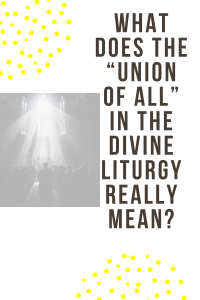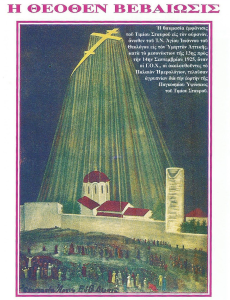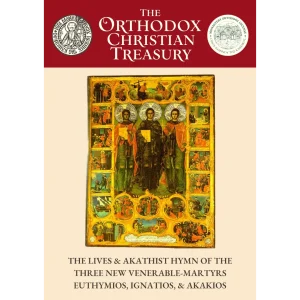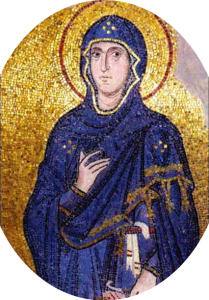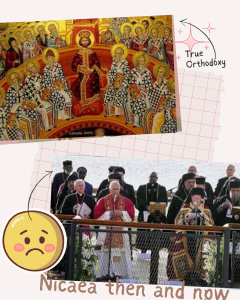ON THE CONDEMNATION OF HERETICS by Vladimir Moss

Condemnation of Heretics

ON THE CONDEMNATION OF HERETICS
Introduction
The writers of the article “On the Status of Uncondemned Heretics”, published by the Synod in Resistance, take issue with two ecclesiological theses:
- 1. “It has been argued that the ecumenists, and, more generally, the ecumenist Churches, have already fallen away from the Body of the Church entirely, that is, they are branches that are automatically cut off from the Vine, and this, indeed, can be demonstrated from the fact that we do not have Mysteriological (Sacramental) communion with them.”
- 2. “It has also been asserted that the Fifteenth Canon of the First-Second Holy Synod in Constantinople, under St. Photios the Great (861), in characterizing the Bishops who preached heresies that had previously been condemned as ‘pseudo-bishops’ and ‘pseudo-teachers’, opened up a new era in a certain way, giving us the right to consider such Bishops, henceforth, as automatically deposed, ‘prior to a synodal decision’, and no longer as being Bishops.”
It is not made clear who is supposed to uphold these two theses, but this is perhaps not important. More surprisingly and more importantly, the article contains only a very brief discussion, with no names or dates, of the heresy of ecumenism, and the synodal verdicts against it: almost the whole of the article is taken up with a discussion of general principles regarding the condemnation of heretics in the context of the period of the Seven Ecumenical Councils. We shall discuss these general principles in a moment. But it is necessary to point out at the beginning that, by refusing to discuss twentieth-century Church history in more than a very superficial way, the article has proved nothing one way or the other with regard to the status of the ecumenist heretics. For how can we say whether the ecumenist heretics are already condemned or not, if we do not discuss the various synodal verdicts that have been considered, rightly or wrongly, to be relevant to their status?
Who Represents the Church?
The only discussion of ecumenism in the article in question comes in the context of the declaration of certain “basic principles”, such as: “a. First and foremost, it is not correct, or even just, that a local Church should be characterized and regarded as ecumenist in toto, simply because a number of Her clergy – and sometimes a small number, at that – are actually ecumenists: they are certainly not to be equated with the local Church.”
Who, then, is to be equated with the local Church? The first-hierarch? The Synod of Bishops? What if the heads of the Churches have endorsed clearly ecumenist statements published jointly with already-condemned heretics, as has happened many times in the World Council of Churches since the 1960s, and at Chambesy in 1990 and Balamand in 1994? What if joint prayers with heretics continue at the highest level (for example, the Pope and the Patriarch of Constantinople in the Vatican itself or in the Phanar) over a period of decades, if not generations? We seek in vain for answers to these questions in this article. In fact, no answer is given to the question it itself raises: who can be said to represent the Local Church?
“b. The local Orthodox Churches today are fundamentally anti-ecumenist; the inertia of the silent majority does not in any way imply agreement with, or endorsement of, ecumenist activities and teachings.”
No evidence is given for this extremely surprising statement. In fact, all the evidence points in the opposite direction. For example, the Phanar and the Vatican appear to be as close as they have ever been. Again, there has been a notable increase in the ecumenical activity of the Moscow Patriarchate since it engulfed ROCOR in May, 2007, including an increased representation at the World Council of Churches. Again, the Antiochian Patriarchate shows no signs of breaking its union with the Monophysites, and the Alexandrian Patriarchate appears to be following its example. The Local Orthodox Churches have been falling over themselves to tread the path to Rome and other heretical centres. Their main quarrel has been not with the heretics, but with each other, as was recently demonstrated at the Orthodox-Catholic talks in Ravenna.
As for the “silent majority”, we cannot determine what they believe for the simple reason that they are silent! But if they are silent, this does not speak in their favour, for, as St. Gregory the Theologian says, “By your silence you can betray God”. Indeed, when the majority is silent in the face of massive betrayal of the faith carried out over generations, there are only two possible conclusions: either they agree with their heretical hierarchs, or they are too indifferent to questions of the faith to make any protest – which Laodicean indifference to the truth is itself the characteristic feature of the ecumenist heresy, as Metropolitan Philaret of New York pointed out …
In any case, the Holy Fathers of the Ecumenical Councils did not come to their decisions after taking democratic opinion polls of the opinions of their flock. Not only did they not have the technology to carry out polls: they were considered irrelevant. For a true bishop, a successor of the apostles and therefore the representative of his diocese, does not need to consult his flock in order to know whether a certain teaching is truth or heresy – he consults only his conscience and the Holy Tradition of the Orthodox Church.
“c. It should not be forgotten that no local Church has proclaimed synodally that the primary dogma of the ecclesiological heresy of ecumenism is a teaching of the Orthodox Church that must be believed and that it is necessary for salvation; and neither has this even been proclaimed in a pan-Orthodox manner.”
The Constitution of the World Council of Churches commits all its members to a Protestant theory of the Church – essentially the ecumenist branch theory. Insofar as each Local Church approved its entry into the WCC at a synodal level, it proclaims ecumenism synodally. Moreover, there are many ecumenist decisions of the World Council of Churches that have been accepted in an official manner by the Local Churches. For example, in 1982, at a conference in Lima, Peru, the Protestant and Orthodox representatives to the WCC agreed that the baptism, eucharist and ordinations of all denominations were valid and acceptable. In 1983 the ROCOR Council of Bishops specifically anathematized not only the branch theory, but also this particular manifestation of the branch theory: “to those… who do not distinguish the priesthood and mysteries of the Church from those of the heretics, but say that the baptism and eucharist of heretics is effectual for salvation… Anathema.”
A particularly clear example of the official acceptance by the Local Churches of the ecumenist branch theory is the Balamand agreement of 1994, in which the Orthodox and the Catholics were declared to be sister-Churches in the full sense, “two lungs” of the same organism (with the Monophysites as a “third lung”?). The Balamand Agreement, which was signed on the Orthodox side by Moscow, Constantinople, Alexandria, Antioch, Romania, Cyprus, Poland and Finland, declared: “Catholics and Orthodox… are once again discovering each other as sister churches” and “recognizing each other as sister churches”. “On each side it is acknowledged that what Christ has entrusted to His Church – the profession of the apostolic faith, participation in the same sacraments, the apostolic succession of bishops, and, above all, the one priesthood celebrating the one Sacrifice of Christ – cannot be considered to be the exclusive property of one of our Churches.” The baptism of penitent papists into the Orthodox Church was prohibited: “All rebaptism (sic) is prohibited.” The Orthodox Church “recognizes the Catholic Church in her entirety as a sister Church, and indirectly recognizes also the Oriental Catholic Churches” (the Uniates). “Special attention should be given on both sides to the preparation and education of future priests with regard to the new ecclesiology, (that they may) be informed of the apostolic succession of the other Church and the authenticity of its sacramental life, (so that) the use of history in a polemical manner (may be avoided)”.
This was an official acceptance of the ecumenist branch theory.
Some argue that these ecumenist decisions signed by representatives of the Local Churches are not binding, because they were not ratified by later synods. However, this is sophistry. Since the time of the First Ecumenical Council, it has been normal practice for the heads of Local Churches to send representatives to Councils, and the decisions signed by these representatives have been accepted as representing the faith of the Local Churches without the need for any further synodal “ratifications”. Of course, it is possible for a Local Church to reject decisions signed by her representatives, as the Roman Church rejected the decisions of the Council in Trullo (692), which were signed by her apocrisiarii. But this is not the case with the ecumenist “councils” of recent decades – no Local Church has expressed any protest against the decisions signed by her representatives.
When is a Schism not a Schism?
The article we are examining proclaims the well-known teaching of the Synod in Resistance that the True Church contains both true believers and heretics, both “healthy” and “sick” members; for “the members of the Body can be ailing, that is, they can be in error regarding the Orthodox Faith, and in this way their spiritual communion with the God-Man can be ruptured; in spite of this, even as ailing members, they are not dead; they continue to belong institutionally to the Body, which is precisely what happens with a healthy human body, in which there can also exist unhealthy cells, or with a tree in bloom, which may also have sickly branches.”
We can agree with this if we are talking about individual lay members of the Church who do not represent the Local Church in the way that a bishop represents his diocese or a patriarch his patriarchate. It is an obvious fact that not every member of the Church has the same understanding of the faith, and some members have a purer and deeper faith than others. But when a hierarch proclaims heresy “with bared head” from the ambon, then, according to the Fifteenth Canon, he is not just a sick member of the Church but a “pseudo-bishop” and a “spiritual wolf”, from whom the other members of the Church must flee if they want to remain inside the Church.
However, the article goes on to argue that such “pseudo-bishops” or “spiritual wolves” still remain members of the True Church, with all the privileges of their Sees (“they presided over thrones and were heretics in the Church”). They remain “sick” members of the Church until they have been excommunicated either (1) by their own actions in separating themselves from the Church into schismatic communities or (2) through synodal verdicts. Thus “when the Holy Ecumenical Synods summoned Nestorios of Constantinople (the Third Synod in Ephesus) and Dioscoros of Alexandria (the Fourth Synod in Chalcedon) three times to appear for judgement, they acknowledge that the heresiarchs in question still occupied their Sees, up to that time, from which they spoke and acted in the name of, and on behalf of, the Orthodox Church.”
Let us consider these two criteria: (1) the creation of a schism, and (2) condemnation by a Synod.
We can agree with the first criterion, i.e. that those who voluntarily depart from the Church into schism “sever, by themselves, their institutional connection with the healthy Body of the Church”, and “such individuals are, and should be considered to be, decisively and ‘entirely cut off’”.
But does not this criterion apply precisely to, for example, the new calendarist ecumenists, who in 1924 separated themselves from the Body of the Church by choosing to celebrate the feasts and fasts of the Church at a different time? For it is inaccurate to say that the Old Calendarists “walled themselves off” from the new calendarists. It is the other way round: the new calendarists separated from the Church by refusing to celebrate the feasts at the time appointed by the Church, while the Church – that is, the Old Calendarists – simply stood where she had always been. And then the new calendarists compounded their sin by synodically condemning the Old Calendarists…
Can a Local Council Cast Out Heretics?
Is a conciliar verdict necessary in order to expel a heretic, as the second criterion declares? At first sight it would seem that the answer to this question is: yes. However, there are grounds for thinking that Arius was invisibly expelled from the Church long before the First Ecumenical Council of 325. For when the Lord Jesus Christ appeared to Hieromartyr Peter, Archbishop of Alexandria, in the form of a twelve-year-old child in torn clothing, and was asked by St. Peter: “O Creator, who has torn Your tunic?”, the Lord replied: “The mindless Arius; he has separated from Me people whom I had obtained with My Blood.” And this took place before St. Peter’s martyrdom in 311. So here we see an exemplification of the Lord’s words to Nicodemus: “He that believeth not is condemned already” (John 3.18), and the Apostle Paul’s words: “A man that is a heretic, after the first and second admonition, reject, knowing that he… is self-condemned” (Titus 3.10, 11).
There is a distinction between the mystical organism of the Church and her visible, external organization. This distinction was worked out in detail by New Martyr Mark (Novoselov), the leader of the Catacomb Church in Moscow, who was shot in 1938. So we could say that Arius was cut off from the mystical organism of the Church by Christ, but was cut off from the external organization of the Church by the Holy Fathers of the First Ecumenical Council. But this distinction does little to help the argument of this article. For of what benefit is it to be a member of the Church’s external organization while being cut off from her mystical organism by the Head of the Church Himself?
Moreover, we must not think, as the writers of this article appear to think, that only an Ecumenical Council can cut off a heretic from the external organization of the Church. Since this is an important point, let us examine several examples from the history of the Church:-
- a. Arius. He was first cut off from the Church, not by the Holy Fathers of the First Ecumenical Council in 325, but by his own bishop, St. Alexander, Archbishop of Alexandria, in local Councils in 321 and 323. The Ecumenical Council was convened because in some parts of the Church St. Alexander’s decision was disputed, and there were even attempts to overthrow it in other local councils. However, the First Ecumenical Council settled the dispute once and for all by confirming the original decision of St. Alexander – who, of course, had the complete right to defrock one of his own priests, but needed the added authority of “the great and holy Synod” of Nicaea in order to confirm his decision.
- b. Nestorius. He was first cut off from the Church by a local Council in Rome under St. Celestine in August, 430, and then by another local Council in Alexandria under St. Cyril. Finally, in 431 the Third Ecumenical Council in Ephesus confirmed the decisions of these local Councils.
- c. Monothelitism. This heresy was first condemned by a local Council under St. Martin the Confessor in Rome in 649. It was condemned again in another local Council under St. Theodore, Archbishop of Canterbury (a Greek from Tarsus), in Hatfield, England on September 17, 679. The decision of the English Church was then brought by St. Wilfrid, Bishop of York, to Rome, where another local Council under St. Agatho condemned the heresy for the third time, on March 27, 680. Finally, in 681 the Sixth Ecumenical Council anathematized it again, confirming the decisions of the three Western Councils. It should be noted that when the heretical bishop Theodosius in conversation with St. Maximus the Confessor disputed the validity of the first of these Councils, of 649, on the grounds that it was not convened by an emperor like the Ecumenical Councils, St. Maximus replied that the validity of a Council depended on its recognising “the true and immutable dogmas”, not on who convened it or how general it was. Again, when the same saint was asked in the Emperor’s palace why he was not in communion with the Throne of Constantinople, he replied: “… They have been deposed and deprived of the priesthood at the local council which took place recently in Rome. What Mysteries, then, can they perform? Or what spirit will descend upon those who are ordained by them?”
- d. Iconoclasm. This heresy was first condemned by a local Council in Rome under Pope Gregory III in 731. This decision was then confirmed by the Seventh Ecumenical Council under St. Tarasius in 787. Bishop Theophan the Recluse points out that before the start of the Seventh Council, its president-to-be, St. Tarasius, bewailed the fact that “we (the iconoclastic Church of Constantinople) are being anathematised by them (the other Local Churches in Local Councils) every day”. There is no suggestion that the saint considered these local decisions to be invalid. Rather, he hastened to bring his Church out from under the anathemas by confessing the true faith. Moreover, those heretics who were united to the Church during the Council confessed that they had been outside the Church before this. Thus we read in the Acts of the Seventh Ecumenical Council. “These are the words of the uniting iconoclasts. Thus Basil, bishop of Ancyra, said: ‘As far as I was able, I investigated the question of the icons and converted to the Holy Catholic Church with complete conviction.’ Theodore, bishop of Myra, said: ‘… I beseech God and your holiness to unite me, the sinful one, to the Holy Catholic Church.’” (pp. 41, 43 in the edition of the Kazan Theological Academy). And here are the witnesses of the holy Fathers of the Council: “His Holiness Patriarch Tarasius said: ‘What is now to be our relationship to this heresy that has again arisen in our time?’ John, the most beloved of God, locum tenens of the apostolic throne in the east, said: ‘Heresy divides every man from the Church.’ The Holy Council said: ‘That is evident.’ The Holy Council said: ‘Let the bishops who are standing before us read their renunciations, insofar as they are now converting to the Catholic Church.’“ (p. 48).
If local Councils did not have the authority to expel heretics from the Church, we should have to condemn many local Councils for exceeding their competency and assuming an authority that did not belong to them. These would include many local Councils of the Early Church, which expelled such heretics as Marcion and Sabellius; the local Councils of the Great Church of Constantinopole between the eleventh and fourteenth centuries that expelled the Roman Catholics; the local Councils of the Russian Church presided over by Patriarch Tikhon that anathematized the communists and their co-workers in 1918 and the renovationist heretics in 1923. However, the Church, which has the mind of Christ, has accepted all of these acts as lawful and valid. To think otherwise – that is, to think that the Church cannot expel heretics through local Councils, but only through Ecumenical ones – is to suppose that for the last 1231 years, since the convening of the last Ecumenical Council, the Church has – God forbid! – lost her God-given power to bind and to loose!
Who has the Right to Anathematize?
That this is in fact the logical consequence of the views propounded in this article is shown by the “Informatory Epistle” of Metropolitan Cyprian of Fili, President of the Synod in Resistance, which was published in 1998. As is well-known, Metropolitan Cyprian denies the rights of Local Councils to expel the ecumenist heretics from the True Church. Still more significantly, he denies the right of any contemporary Synod to anathematize heretics.
Thus he writes: “3 (c). The right to issue an anathema does not belong to ecclesiastical administrative bodies which have a temporary synodal structure, but which do not possess all the canonical requisites to represent the Church fully, validly, and suitably for the proclamation of an anathema – a right and “dignity” which is “granted” only to the choir of the Apostles “and those who have truly become their successors in the strictest sense, full of Grace and power…
“5 (a). The extremely serious implications of an anathema, coupled, first, with the absence, in our day, of a synodal body endowed with all of the aforementioned canonical prerequisites for proclaiming an anathema and, secondly, with the immense confusion that prevails, on account of ecumenism, in the ranks of the local Orthodox Churches, constitute, today, a major restraint on, and an insurmountable impediment to, such a momentous and, at the same time, historic action.”
In other words, the True Church today no longer has the power to anathematize heretics! This implies that the anathema against ecumenism issued by the Russian Church Abroad in 1983 was invalid because it exceeded the competence of that, or any other contemporary Synod. It also implies that if the Antichrist were a member of one of the Local Orthodox Churches, and were to proclaim himself as God today, the One, Holy, Catholic and Apostolic Church would be powerless to expel or anathematize him!
There is no doubt that the Church is in a disorganized and weakened state today. And yet the fullness of the power of God still lives in Her, and will live in Her until the end of time, as the Lord promised. She still has true bishops, and these bishops still have the power to bind and to loose that was given them by the Holy Spirit. When St. Maximus defended the right of the Lateran Council in 649 to expel the Monothelite heretics from the Church, he did not discuss a whole list of “canonical prerequisites for proclaiming an anathema”, but gave as the only “canonical prerequisite” the possession of “the true and immutable dogmas”, i.e. Orthodoxy. And so if our bishops are truly Orthodox they have the right to anathematize any heretic anywhere – to think otherwise is to lose faith in the Church Herself.
The Fifteenth Canon
The authors of the article we are examining declare that the Fifteenth Canon of the First-Second Council of Constantinople, which allows Christians to separate from a bishop who proclaims heresy publicly even before a synodal trial, nevertheless does not give anyone the right to declare a heretic automatically deposed. And in their support they cite St. Nicodemus the Hagiorite’s commentary on the 30th Apostolic Canon: “The Canons ordain that a synod of living bishops should defrock priests, or excommunicate or anathematize laymen, when they transgress the Canons. However, if the synod does not put into practical effect the defrocking of the priests, or the excommunication or anathematization of the laymen, these priests and laymen are neither defrocked nor excommunicated nor anathematized in actuality [ ). However, they are subject to defrocking and excommunication here, and to the wrath of God there.”
This sounds eminently reasonable. After all, in the secular world, a man is counted innocent of a crime until he is judged guilty in a court of law; if I exceed the speed limit in my car, I am not deprived of my licence to drive until I have been judged by a competent magistrate. If such caution is exercised in secular judgements, should not even more caution be exercised in the far more important sphere of ecclesiastical jurisprudence?
And yet the Canon calls those bishops who proclaim heresy openly as “pseudo-bishops” even before a synodal decision. This is strong language, and the authors of the article try to lessen the impact of this language as follows: “The characterization of a Shepherd as a ‘pseudo-bishop’ ‘prior to a synodal decision’ is heuristic or diagnostic in nature (the doctor ascertains the disease) and not final and juridical or condemnatory (the doctor diagnoses the incurability of the ailing member and reaches a firm decision to amputate it).”
But this explanation is unconvincing. Why should the canon call the “uncondemned heretic” a “pseudo-bishop” if he is in fact still a true bishop, and praise those who break with him immediately if he is in fact not yet condemned? It cannot be that the Canon is inciting laymen to judge their bishops without waiting for the only competent judgement – that of bishops meeting in council. More likely: heresy is such a serious matter that everyone, according to the canon, must have the right to flee from it immediately, without waiting for confirmation by a higher authority, just as one would flee from a plague victim immediately, without waiting for confirmation from a doctor. However, if, as the writers of our article affirm, an “uncondemned heretic” is still an Orthodox hierarch in the full sense, then there is great danger in fleeing from him before synodal condemnation – the danger, first of all, of depriving oneself of the grace-filled sacraments he dispenses, and secondly, of becoming a schismatic by separating oneself from the Church.
In order to resolve this problem, it will be useful to recall the words of St. Theodore the Studite. Writing to Bishop Euthymius of Sardis, he says: “You know, your Reverence, that by the common voice of the confessors who are still on the earth and those who have departed to the Lord it has been decreed that clergy who have been once convicted of communion with heretics should be banned from serving until review by Providence on high. How can we transgress this rule and by receiving one person extend the law to all those previously banned and thereby act contrary to our divine and highest superior… and deceive others from the confessors and produce discord among people who strictly follow the rules?”
And again: “You know, honoured of God, that by common agreement of the confessors still alive on the earth and of those who have recently appeared before the Lord, it has been decided to ban from serving those who have been seduced even only once into communion with the heretics – it goes without saying, until the time of the visitation of God’s Providence, that is, until the convening of a Council that re-establishes Orthodoxy.”
So even before a Council that looks into each case in detail, those in communion with heresy are banned from serving.
Moreover, there is other evidence from the period of the Ecumenical Councils that a bishop who preaches heresy publicly loses his authority even before he is deposed by a Council. Thus St. Celestine, Pope of Rome, wrote to the clergy of Constantinople who were opposing Nestorius: “The authority of our Apostolic See has determined that the bishop, cleric or simple Christian who has been deposed or excommunicated by Nestorius or his followers, after the latter began to preach heresy, shall not be considered deposed or excommunicated. For he who had defected from the faith with such preachings cannot depose or remove anyone whatsoever.”
Again, St. Nicephorus of Constantinople wrote about unrepentant iconoclasts: “Insofar as they have deprived themselves of that teaching of the faith in which they had been consecrated, they have of necessity been deprived on their ordination and deposed as teaching other things…“ “They must have been deprived of the anointing of the Spirit as soon as they renounced the confession, for it is impossible for them to transgress the faith with which they were anointed, and [at the same time] to carry out that which [is given] by the anointing.”
It is clear, therefore, writes Christopher Gorman, “from the cited canonical, conciliar and Patristic witness, that when a bishop publicly and pertinaciously embraces a heresy over an extended (albeit canonically undefined) period of time, a process of deprivation begins to occur, which gradually strips him of his administrative, teaching and sanctifying authority, which can lead, in certain cases, to de facto deposition and expulsion from the Church, even without an official pronouncement by a competent council.”
Bishop Theophan the Recluse (+1894) said that there was no need for further conciliar anathemas to condemn the heretics of his day since they had all already been condemned by earlier decisions. Commenting on St. Paul’s words, “If anyone preaches any other gospel that that which we have preached unto you, let him be anathema” (Galatians 1.8), he writes: “The apostle laid only the beginning to anathematization. Since then all the opinions worthy of this punishment have already been marked out by the Church. At the present time there is no point waiting for a special ecclesiastical act to strike the evildoers with this judgement. They themselves are placing their own heads under this sword immediately they acquire opinions contrary to the truth and stubbornly begin to insist on them.”
Here Bishop Theophan appears to be endorsing the strict, “non-heuristic” interpretation of the Canon. The “new” heretics of his time did not need synodal condemnation because their teachings were not, in fact, new, but known and condemned long ago by the Church. Theoretically, a new heresy not already condemned by the Councils or the Fathers would need a conciliar condemnation, but Bishop Theophan doubts that any such new heresy exists.
And yet the Church in the twentieth century continued to condemn heretics and heresies. Thus in 1901, the Church anathematized Tolstoy. Then came condemnations of the heresy of name-worshipping (1913), the Bolsheviks (1918), the renovationists (1923), the neo-renovationists or sergianists (1928, 1937), the sophianists (1935), the new calendarists (1935, 1974, 1991) and the ecumenists (1983, 1998). All of these heresies, with the possible exception of name-worshipping, were, in fact, old and therefore already condemned. For is not Sergianism simply the sin of Judas in a new guise? As for ecumenism, “the heresy of heresies”, “it is impossible not to recognise that it contains a multitude of old heresies [i.e. all the old heresies that the ecumenists enter into communion with], from which every one of the hierarch-ecumenists gave an undertaking to defend Orthodoxy”.
What, then, has been the purpose of these recent Councils? First of all, to warn the faithful who may not be well-versed in theology that here is a heresy, and to explain its nature and its non-correspondence with the Holy Tradition of the Orthodox Church. Secondly, in order to make a clear separation between light and darkness, between the Church of the faithful and the “Church of the evildoers”, lest the latter swallow up the former entirely. And thirdly, to reverse the act that the Church carried out when she made the heresiarchs pastors and bishops.
However, the most important point is this: that there is God’s judgement and there is man’s judgement, and God’s judgement precedes man’s judgement, which consists essentially in discerning and declaring publicly that God has already judged the heretic. So the power of anathema held by the hierarchs of the Church is not held independently of God’s judgement, but strictly in consequence of it and in obedience to it. That is why heretics are “pseudo-bishops” even before a synod of bishops has condemned them – for God has already judged them.
As St. Dionysius the Areopagite writes: “Insofar as the [hierarch] makes known the judgements of God, he has also the power of excommunication. Not indeed that the all-wise Divinity gives in to his every unthinking impulse, if I may so speak with all reverence. But the hierarch obeys the Spirit Who is the source of every rite and Who speaks by way of his words. He excommunicates those unworthy people whom God has already judged. It says: ‘Receive the Holy Spirit. If you forgive the sins of any, they are forgiven; if you retain the sins of any, they are retained.’ And to the one enlightened by the sacred revelation of the All-Holy Father it is said in Scripture: ‘Whatever you bind on earth shall be bound in heaven, and whatever you loose on earth shall be loosed in heaven.’ Thus [Peter] himself and all the hierarchs like him have had the judgement of the Father revealed to them, and, being themselves men who provide revelation and explanation, they have the task of admitting the friends of God and of keeping away the ungodly. That sacred acknowledgement of God came to him, as Scripture shows, not on his own, not from a flesh-and-blood revelation, but as something from the understanding and under the influence of the God Who initiated him into what he knew. Similarly, God’s hierarchs must use their powers of excommunication, as well as all their other hieratic powers, to the extent that they are moved by the Divinity which is the source of every rite. And everyone else must obey the hierarchs when they act as such, for they are inspired by God Himself. ‘He who rejects you,’ it says, ‘rejects Me’.”
Conclusions
- 1. A heretical bishop is condemned immediately he utters his heresy publicly and unashamedly. He is cut off from the mystical organism of the Church by the invisible hand of Her Head and Chief Priest, the Lord Jesus Christ. For it is the Lord, and the Lord alone, Who has “the keys of hell and of death” (Revelation 1.18) – that is, “authority over the death of the body and the soul” (Archbishop Averky).
- 2. While invisibly cut off from the mystical organism of the Church, the heretic may remain for a time a member of the visible organization of the Church. However, the faithful have the right to separate from him even while he remains within the visible organization of the Church; and in this case, they, and not the heretic, should be called Orthodox. For, as St. Sophronius of Jerusalem writes: “If any should separate themselves from someone, not on the pretext of a [moral] offence, but on account of a heresy that has been condemned by a Synod or by the Holy Fathers, they are worthy of honour and approbation, for they are the Orthodox.” And, as St. Nicephorus of Constantinople writes: “You know, even if very few remain in Orthodoxy and piety, then it is precisely these that are the Church, and the authority and leadership of the ecclesiastical institutions ( ) remains with them.”
- 3. Any Council of truly Orthodox Bishops, of whatever composition or generality, has the power to bind and to loose – that is, to cut off the heretic from the visible organization of the Church. But this power consists in discerning that God has already condemned the heretic in question. For, as St. Bede the Venerable writes: “The keys of the Kingdom designate the actual knowledge and power of discerning who are worthy to be received into the Kingdom, and who should be excluded from it as unworthy” – and this knowledge and power depend, not on numbers, but on grace.
- 4. Any man who, while not “alienated in matters concerning the Faith itself”, nevertheless “separates himself for certain ecclesiastical reasons and questions capable of mutual solution”, is a schismatic according to the definition of St. Basil the Great, and has “condemned himself” (Titus 3.11). For, as the Lord says, “He who is not with Me is against Me” (Matthew 12.3), and, as St. Cyprian of Carthage says, “there is no salvation outside the Church”.
- 5. Therefore the ecumenists and new calendarists, having both uttered heresies condemned by the ancient Councils and Fathers, and having been cut off by living Councils of Bishops (i.e. Bishops contemporary with them), and having separated themselves into schismatic communities independent of the Church, belong neither to the mystical organism of the Church nor to its visible organization. For, as one of those Councils declared on June 8/21, 1935: “We recommend to all those who follow the Orthodox Calendar that they have no spiritual communion with the schismatic church of the schismatic ministers, from whom the grace of the All-Holy Spirit has fled, because they have violated the decisions of the Fathers of the Seventh Ecumenical Council and the Pan-Orthodox Councils which condemned the Gregorian calendar. That the schismatic Church does not have Grace and the Holy Spirit is affirmed by St. Basil the Great, who says the following: ‘Even if the Schismatics have erred about things which are not Dogmas, since the head of the Church is Christ, according to the divine Apostle, from Whom all the members live and receive spiritual increase, they have torn themselves away from the harmony of the members of the Body and no longer are members [of that Body] or have the grace of the Holy Spirit…’”
Vladimir Moss.
March 5/18, 2008; revised March 6/19, 2009.

